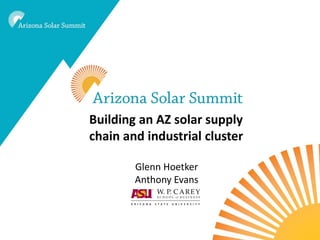Building an AZ solar supply chain and industrial cluster
- 1. Building an AZ solar supply chain and industrial cluster Glenn Hoetker Anthony Evans
- 2. Our mission More investment in solar energy production and supply chain capacity is attracted to Arizona as a result of tighter linkages within the cluster. These linkages extend among the value chains, the talent development systems, the research base, investors, and public policies.
- 3. Our approach ŌĆó Identify the characteristics of a successful industrial cluster ŌĆó Identify factors inherent in robust supply chain development ŌĆó Identify core clusters and their supply chains ŌĆó Identify critical gaps ŌĆó Recommend steps to close gaps and key players to engage ŌĆó Identify new directions to further build cluster capability ŌĆó Set milestones and fill gaps in collaboration
- 4. Membership Bud Annan, Arizona State University Fred Buss, Town of Gila Bend Bennett Curry, Arizona Commerce Authority Anthony Evans, Arizona State University Glenn Hoetker, Arizona State University Michael Neary, AriSEIA Ron Vokoun, Mortenson Construction
- 5. Utility scale Paloma plant (First Solar, 17 MW PV) Cotton Center (Solon, 17 MW PV) Solana (Abengoa, 280 MW Concentrating solar)
- 6. Distributed generation ASU Solar Parasol (Strategic Solar Energy/NRG Solar, 2.5 MW PV)
- 8. AZ solar industry - snapshot ŌĆó 300-400 AZ firms easily meet current in-state demand ŌĆó Range of solar technologies ŌĆō Photovoltaic (PV) ŌĆō Concentrated Solar Power (CSP) ŌĆō Solar Heating & Cooling (SHC) ŌĆó Technology-specific supply chains
- 9. Photovoltaic supply chain (pre-construction/installation) RAW WAFER SOLAR SOLAR SOLAR INGOT MATERIAL MFG CELLS MODULE PANEL ŌĆó U.S. largest polysilicon producer in 2008 (43%) but China, Taiwan and South Korea are now the key players ŌĆó Limited U.S. wafer manufacturing facilities ŌĆō Hemlock and MEMC ŌĆó North America = 7.4% of global cell production capacity (2010) ŌĆó North America = 8.7% of global module production (2009)
- 10. CSP supply chain (pre-construction/installation) ŌĆó Greater opportunities for localized manufacturing ŌĆó Components cut across technologies ŌĆō Mirrors, reflectors, collector structures, heat transfer fluids, salts, turbines, steel etc. ŌĆó 18 CSP U.S. mfg facilities in 2009 ŌĆó SolanaŌĆÖs U.S. supply chain = 29 companies in 22 states ($730 million) ŌĆō 23% invested in AZ
- 11. AZ solar-related employment ŌĆó Solar Foundation (2011) 4,786 solar jobs at 900 AZ establishments ŌĆō 3rd largest state for solar jobs ŌĆó BLS suggest 49,717 jobs across all green goods and services (GGS) ŌĆō 23rd largest state for GGS jobs ŌĆó SEIA survey still in progress ŌĆó Seidman survey: 5,500-7,400 solar jobs ŌĆó 0.2-0.3% of AZŌĆÖs non-seasonally adjusted non-farm employment
- 12. AZ solar-related employment Employment Opportunities by Sector 383 814 8% 17% Manufacturing 1292 Installation 27% R&D Sales 1723 Other 574 36% 12% Source: Solar Foundation (2011)
- 13. AZ competitive advantages ŌĆó Solar insolation ŌĆó Proximity to California ŌĆó Land/resource availability ŌĆó Streamlined zoning and permitting ŌĆó Solar construction know-how ŌĆó On the job learning and innovation ŌĆó University research community ŌĆó Workforce supply
- 14. Cluster potential ŌĆó Viable solar cluster drives economic growth: ŌĆō Project employment and input impacts ŌĆō Attracts new downstream local suppliers ŌĆō Encourages certification ŌĆō Firms can export know-how out-of-state ŌĆó Limited potential for solar PV manufacturing ŌĆó Greater supply chain opportunities for other solar technologies ŌĆó Construction sector could be a real winner
- 15. Supply chain cluster example ŌĆó Construction = biggest benefactor ŌĆó Supply of steel, concrete, mirrors, nuts, bolts and electrical supplies ŌĆó Short-term employment impacts: ŌĆō Utility-scale plants = 1000+ jobs ŌĆō Commercial DG = 50-100 jobs ŌĆō Residential DG = 1-2 jobs ŌĆó Key: convert the jobs into job years
- 16. Challenges and barriers ŌĆó Utilities have almost met RPS targets ŌĆó Energy demand increases >1% each year ŌĆó Positive construction impacts will dry up ŌĆó Residential taxes and incentives are on a per household basis, not per system installed ŌĆó New AZ homes still built without solar ready ordinances ŌĆó Availability of capital investment ŌĆó Lack of optimism within the local industry ŌĆó Potential migration to states with opportunities
- 17. Cluster solution 1: Export Strategy ŌĆó Effective export strategy essential ŌĆó Principal target: California ŌĆó Significant job creation opportunities ŌĆó Galvanize inter-state dialogue to resolve transmission barriers
- 18. Cluster solution 2: R&D ŌĆó AZ solar R&D center ŌĆó Close co-operation between education, utilities, public and private sector ŌĆó CA ahead for solar training and courses ŌĆó But AZ is starting to catch up: ŌĆō First Solar/City of Phx/ASUŌĆÖs new solar engineering & commercialization certification ŌĆō ASUŌĆÖs new PSM (first in U.S.)


















